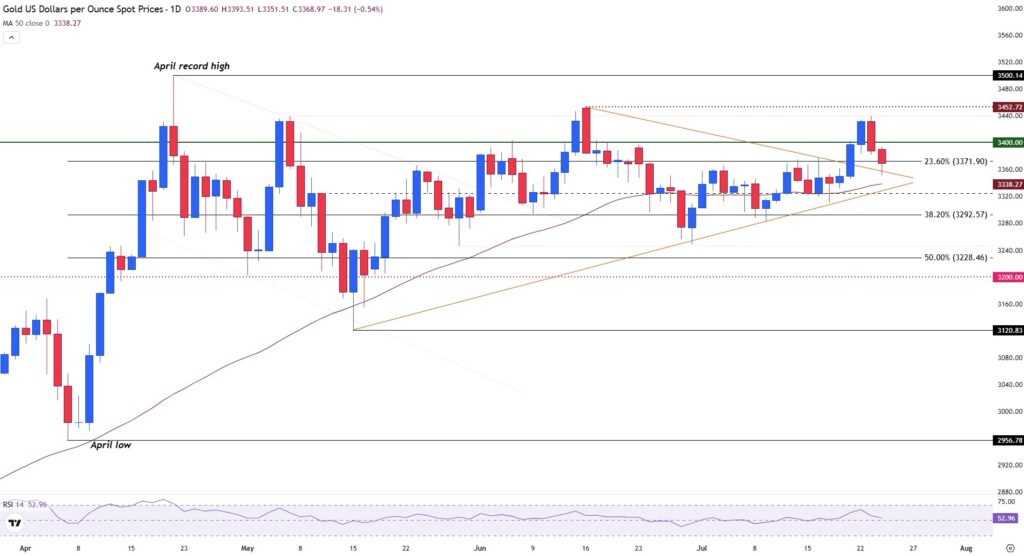
July 24–25, 2025 — Gold prices dipped slightly after reaching a recent peak, pressured by renewed strength in the U.S. dollar and a growing appetite for riskier assets. Improved sentiment surrounding trade deals between the U.S., Japan, and EU investors weighed on demand for the safe-haven metal, though softness in U.S. Treasury yields helped cap losses.
📌 Key Drivers Behind the Pullback
Trade Optimism Reduces Safe‑Haven Need A new U.S.–Japan trade agreement, including a 15% tariff on U.S. imports from Japan, and ongoing U.S.–EU negotiations boosted market sentiment. Investors showed increased interest in equities, dampening gold demand. U.S. Dollar Strengthens Amid Resilient Economic Data While equities rallied on positive economic surprises—strong retail sales and low unemployment claims—the U.S. dollar gained strength, making gold relatively more expensive for foreign buyers. Yields Fall, Supporting Gold’s Floor U.S. Treasury yields declined slightly, which softened the impact on gold by lowering the opportunity cost of holding a non-yielding asset.
💰 Market Snapshot
Spot Gold (XAU/USD):
Trading near US $3,423 per ounce, down about 0.2% from the previous session.
U.S. gold futures also eased, moving to around US $3,436/oz.
Other precious metals showed modest movement:
Silver inched lower Platinum steady around $1,411/oz Palladium dipped slightly to approximately $1,265/oz
🔍 What It Means for the Outlook
Range-Bound Near-Term View: With risk sentiment improving and the USD holding firm, gold is likely to consolidate in the $3,400–$3,450 band. Key near-term resistance lies around $3,450, while solid support may reside near $3,360–$3,380. Medium-Term Outlook Remains Constructive: According to the World Gold Council, gold gained roughly 26% in the first half of 2025, driven by a weaker dollar, geopolitical tensions, and robust investor inflows. Even if optimism continues, gold may rise further by 0%–5% through year-end, or significantly more under disruptive scenarios. Macro Risks May Reignite Interest: Potential drivers such as slower global growth, geopolitical flare-ups, or Fed rate policy shifts could reignite safe-haven flows into gold, particularly if trade tension escalates again ahead of the August 1 deadline.
🔭 What to Watch Next
Upcoming U.S. data: Retail sales, jobless claims, and inflation prints will help determine the trajectory of the U.S. dollar and Treasury yields. Central bank signals: Any hints from the Federal Reserve on potential rate cuts could reignite gold demand. Trade negotiations: Progress or setbacks in U.S.–EU, U.S.–China, and U.S.–Japan discussions could affect risk sentiment. Geopolitical developments: Renewed tensions in key global regions could shift investor flows back toward safe-haven assets.
